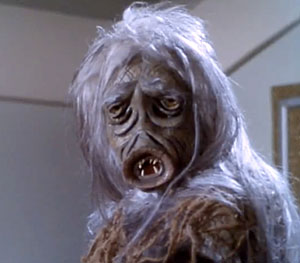 Rummaging through my DVDs last night looking for something to watch in the hour before bedtime, I decided it was time to start rewatching the original run of Star Trek again. And what better way to celebrate than by blogging a few comments on every episode as I watch it? I’m sure there are dozens of people doing the same thing, but why let a little thing like that stop me?
Rummaging through my DVDs last night looking for something to watch in the hour before bedtime, I decided it was time to start rewatching the original run of Star Trek again. And what better way to celebrate than by blogging a few comments on every episode as I watch it? I’m sure there are dozens of people doing the same thing, but why let a little thing like that stop me?
Technical notes first: I have the original non-remastered DVD edition of the episodes, packaged in plastic boxes with a groovy 1960s shape, in the three uniform colours: yellow, red, blue. The boxes look great, but are a real pain to get the discs out of and back into. At some point I may have to pick up the remastered versions.
Anyway, the first episode of Star Trek that ever went to air, and the first in order in the DVD set, is “The Man Trap“. This was actually the 6th episode produced, but was promoted to first to air because it had a relatively straightforward plot, showed off an alien planet, and had a “monster” in it to create thrills. And a memorable monster it is – everyone familiar with Star Trek knows the salt vampire!
As the first episode to air, it’s interesting to see that it has several of the features you want in an introductory episode. All of the major characters are referred to explicitly by name, first soon after they appear and then most of them again later on. But we are also thrown straight into some character moments that obviously have backgrounds. Dr McCoy’s old flame is a plot element and won’t be returning in later episodes, but the romantic tension between Uhura and Spock is encapsulated nicely and will become a recurring theme.
The other thing that struck me was how obviously this episode was set in the social attitudes of the day. Star Trek was of course progressive for its time, with a black female senior officer – and an Asian helmsman and an alien first officer – without any particular attention drawn to the fact that this was not unusual on a starship crew. But there are also some glaring moments of 1960s sexism present, such as when Dr Robert Crater laments that he likes the solitude of living alone on an alien archaeological planet, but states plainly that his wife, being a woman, obviously needs social contact. And there is a scene where two male crewman are ogling and making suggestive comments about Yeoman Janice Rand.
And in this episode we see the first of the mixed moral messages that Star Trek seems to deliver. Dr Crater makes an appeal for the life of the creature, stating that it is the last one of its kind and making allusions to the passenger pigeon and – of all things – the American bison (which he calls “buffalo”). Spock makes the connection, pointing out how the passenger pigeon and “buffalo” are now regrettably extinct – a future prediction made in the days of 1960s environmentalism, which seems out of date now, but in a good way, because it’s now much less likely that the bison will die out. So this comes across as a laudable message about the preservation of species. It’s all undone at the end though, when the creature is unceremoniously killed. Presumably being a danger to the Enterprise crew trumps any concerns over species preservation.
In this episode it’s unclear who Yeoman Rand is assigned to assist. She’s shown taking a meal to Sulu and discussing his exotic alien plants with him, and is in no scenes with Kirk. If this was the only episode you ever saw, you’d assume she worked for Sulu. Those plants, by the way, are very hokey, with one animate specimen obviously someone with a hand in a fuzzy pink glove. I don’t remember if we ever see Sulu cultivating plants again – it seems like it’s being set up as a character note for him, but I don’t recall it appearing any other time.
Another feature that becomes obvious in this episode is just how much tighter television writing is these days. Several minutes of the plot could have been condensed into a fraction of the time – it really felt like they were padding it out to fill the hour (minus ad time). But even given all of these criticisms, it’s a decent 50 minutes of television drama, and certainly not the worst Star Trek episode.
Body count: 3 dead Enterprise crew, 1 dead salt vampire.
Tropes: Last Of His Kind, Doppelganger, Doppelganger Replacement Love Interest, Shape Shifter Guilt Trip, This Was His True Form, Jeannie Cut.
(Image © 1966 Paramount Studios, used under Fair Use.)

Regarding Sulu’s plant cultivation, see the trope “Fleeting Passionate Hobbies”
In the U.S. American Bison are commonly referred to as Buffalo.